A detailed look at the front of Kronebreen, Svalbard
Thanks to some nice boat trips this September (and a good zoom lens on my camera*), we were able to take a detailed look at the calving front of Kronebreen, a fast-flowing glacier which terminates into Kongsfjorden, an inlet on the west coast of Svalbard. Since 2011, Kronebreen has been retreating significantly faster (approx. 100m per year) and the front (where the ice meets the fjord water) has changed drastically. What is interesting is that the calving front does not appear uniform - the distinctiveness of each section indicates that different processes are active. If this intrigues you then please read on! If not, then sit back, relax, and enjoy the pictures at least!
All photos were taken on the Sony NEX-5R with the Sony E 55-210 mm f/4.3-6.3 lens and the Sony E 20 mm f/2.8 lens.

Kronebreen glacier (centre) viewed from the west this September (2016). Kronebreen shares its southern (right) margin with Kongsvegen, a slow-moving surge-type glacier that has been fairly inactive for the past couple of years. The glacier adjacent to Kronebreen, separated by the mountain Collethøgda (left), is called Kongsbreen. Kongsbreen has been retreating from the fjord onto land since approximately 2014.
Kronebreen ('crown glacier') is a heavily crevassed glacier tongue fed from a large ice field called Hotledahlfonna, flowing between 1-5 metres per day into Kongsfjorden, an inlet on the west coast of Svalbard (see here for more information on Kongsfjorden and Svalbard). The front of Kronebreen is approximately 3 km, forming an impressive ice face that deposits ice into the fjord to form icebergs. This process is called calving and is one of the main processes by which ice is transferred from land to sea. For more information on Kronebreen, please refer to another post I wrote on why small glaciers are important to study here.
In many settings (such as at the large glaciers found in Greenland), the front of a glacier is a tall cliff of ice from which large sections of ice calve off. From studying the front of Kronebreen though, it is apparent that the ice face is not uniform. Certain sections of the ice front look entirely different from one another, suggesting that the controls on calving are also different. There are five sections that are particularly interesting:
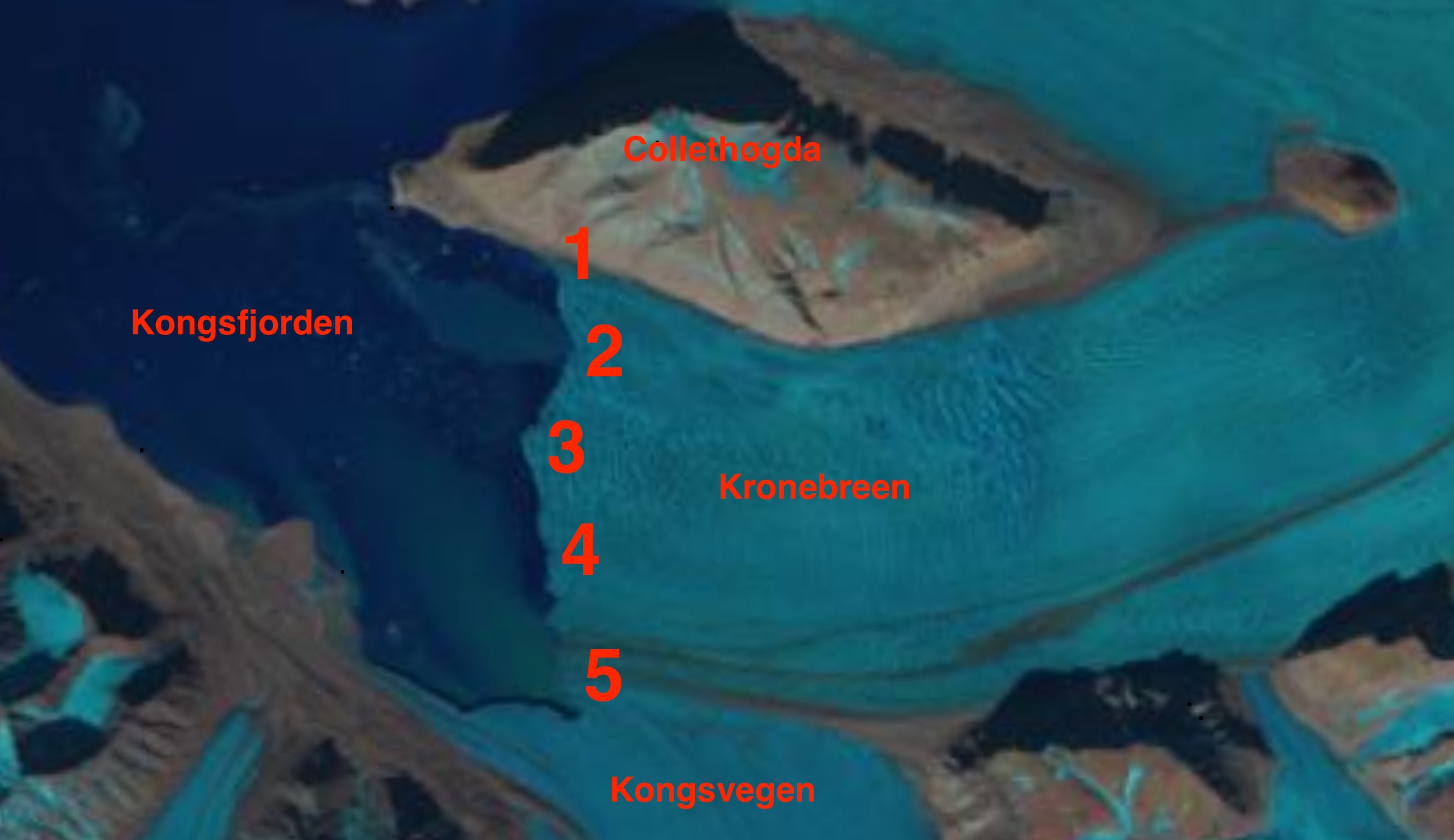
Numbered sections of the calving front of Kronebreen (Landsat image from 09/07/2016, downloaded from USGS LandsatLook Viewer)
- The glacier margin next to Collethøgda
- The retreated region around a large submarine plume that forms during the summer melt season each year (since at least 2011)
- The pinnacle - the middle section of glacier that is the furthermost point of the ice front
- The 'traditional' tall ice cliff at the front of the fastest-flowing section of the glacier
- The shared margin with Kongsvegen
1. The glacier margin next to Collethøgda
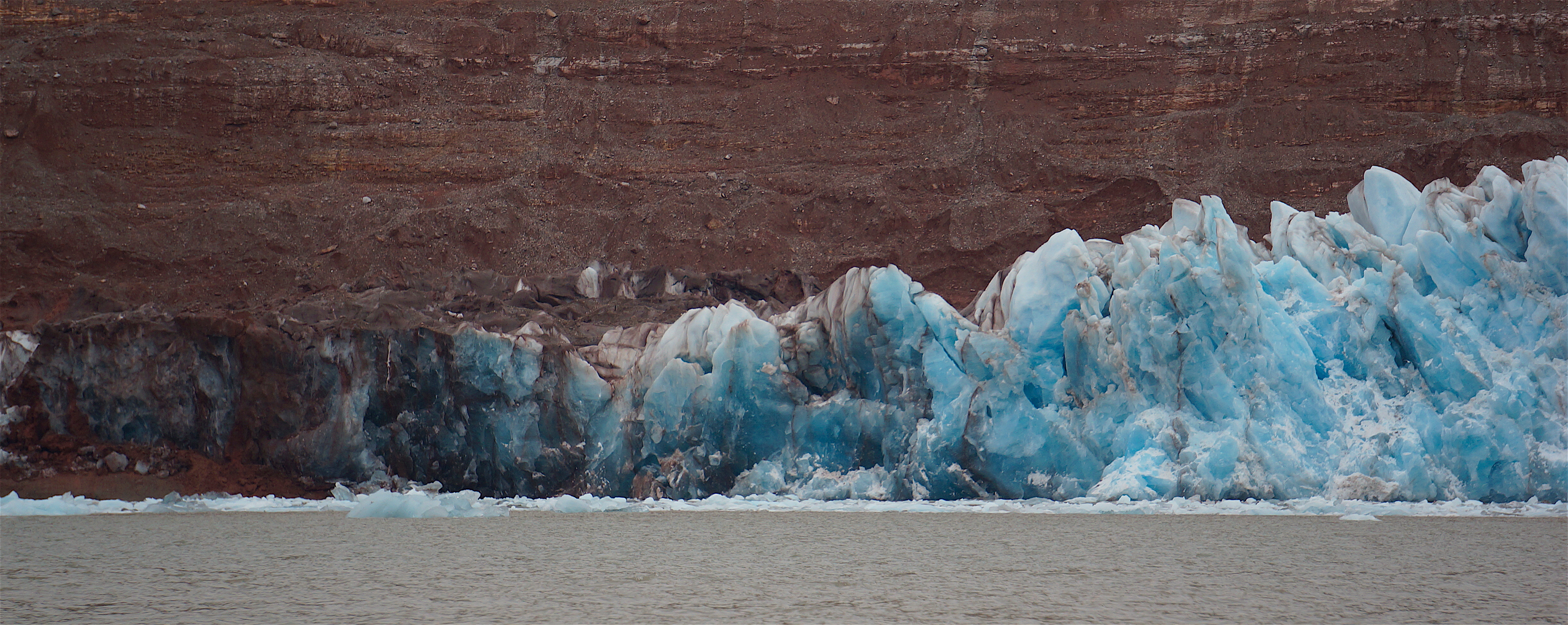
The north margin of Kronebreen. This section tends to flow much slower as the ice shears against the land from lateral drag. A lot of the land (at the foot of Collethøgda) is ice-cored - as the glacier has retreated, ice has been left isolated at the margin which is buried over time due to landslides and rockfalls from above.

A close-up of the north margin. The ice face appears broken up because it has been subject to compressive flow deformation further upstream - marginal crevasses form as the ice shears. These crevasses form weaknesses in the ice front when the ice is transferred downstream. Generally the calving activity in this margin zone is caused by exploitation of these weaknesses, producing ice falls and small collapses.
2. Region around a large submarine plume
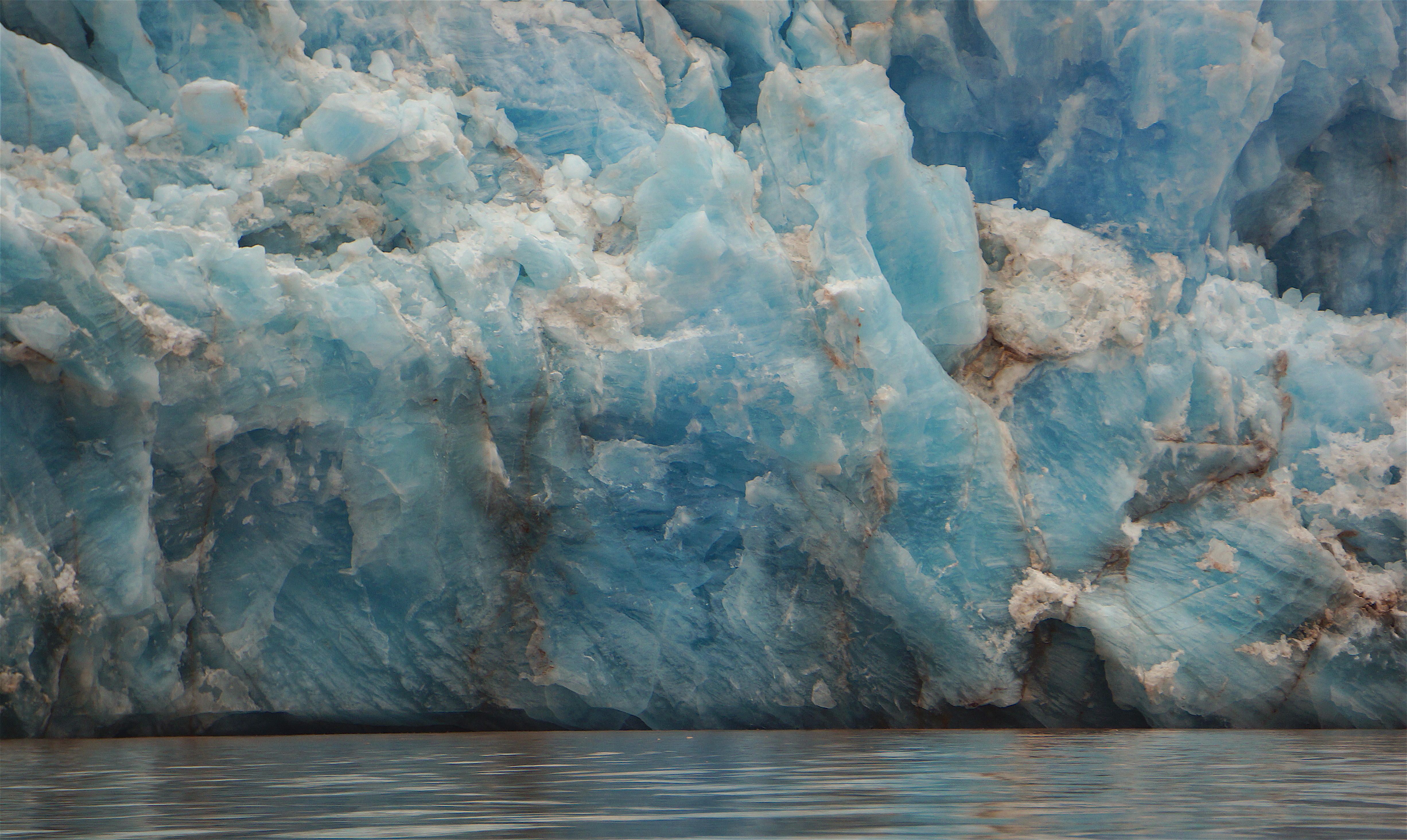
Undercutting at the waterline exposed during low tide. Turbulence at the interface between the ice face and the fjord water causes undercutting. During low tide, this undercut section is exposed which creates a weakness in the front (from the undercutting) and the ice flow marginally increases (from the reduction of hydraulic head). It is thought that there is a correlation between calving activity and tidal patterns, but it has been challenging to thoroughly test this hypothesis. This undercutting occurs over the entire front of Kronebreen, with a tidal range of roughly 1 metre (excluding spring/neap tides). Marked undercutting is noted to occur in areas where a submarine plume is active.
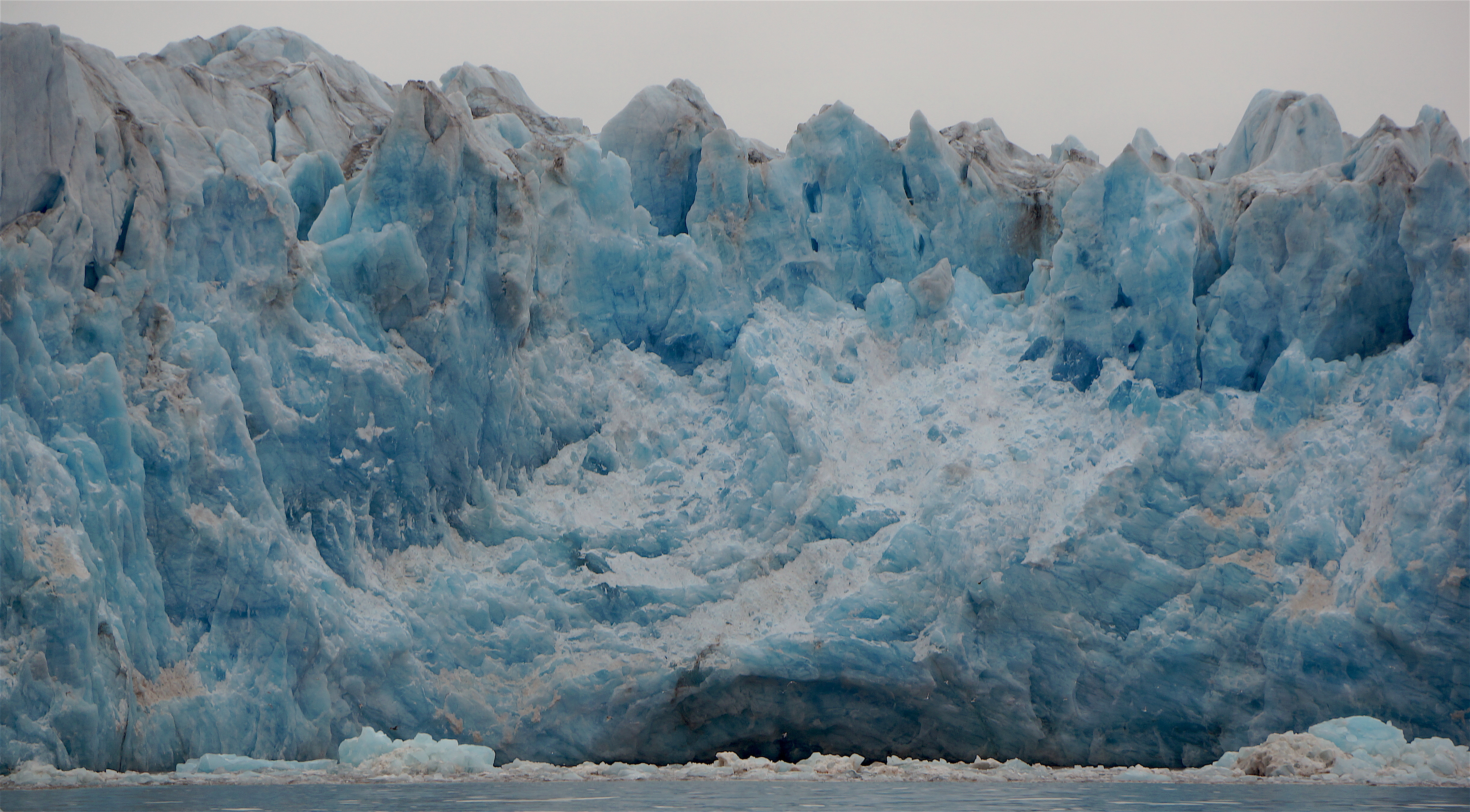
A significant undercut chasm located where a submarine plume emerges from Kronebreen consistently year on year. In the summer melt season, meltwater is channeled through large tunnel networks in the glacier, exiting into the fjord as large bodies of freshwater. The freshwater rises as it comes into contact with the fjord as freshwater is lighter than salt water, creating a turbulent column of water that promotes melting/cutting in the adjacent ice column below the waterline. The plume is visible at the surface when it is strong enough to generate turbulence through the entire water column (click here to see a visible plume at Tunabreen in August 2015). Turbulence from the plume also can cut back into the ice column as we see at Kronebreen, forming chasms in the ice front where melt-back beneath the waterline causes small collapses above the waterline.
3. The pinnacle - the middle section of glacier that is the furthermost point of the ice front
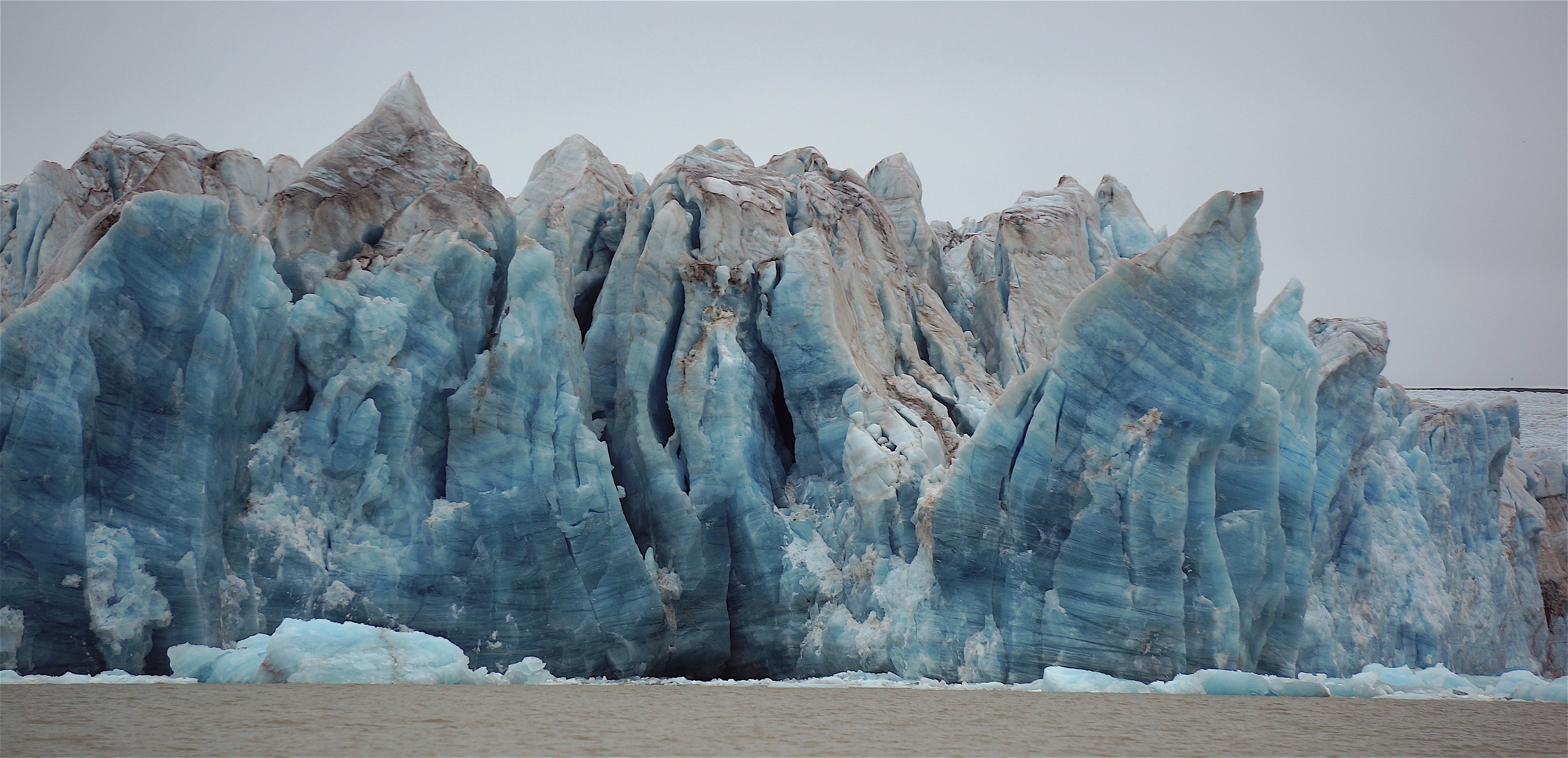
The ‘pinnacle’ of the calving front at Kronebreen (viewed from the north side). The face is not the usual smooth, clean-cut ice cliff you see in marine-terminating settings. Instead, the calving front is composed of ice columns which rest at different orientations to one another. Ice flow from behind the calving front is pushing these columns into the fjord, often causing these columns to calve into the fjord with rotations… and big splashes!
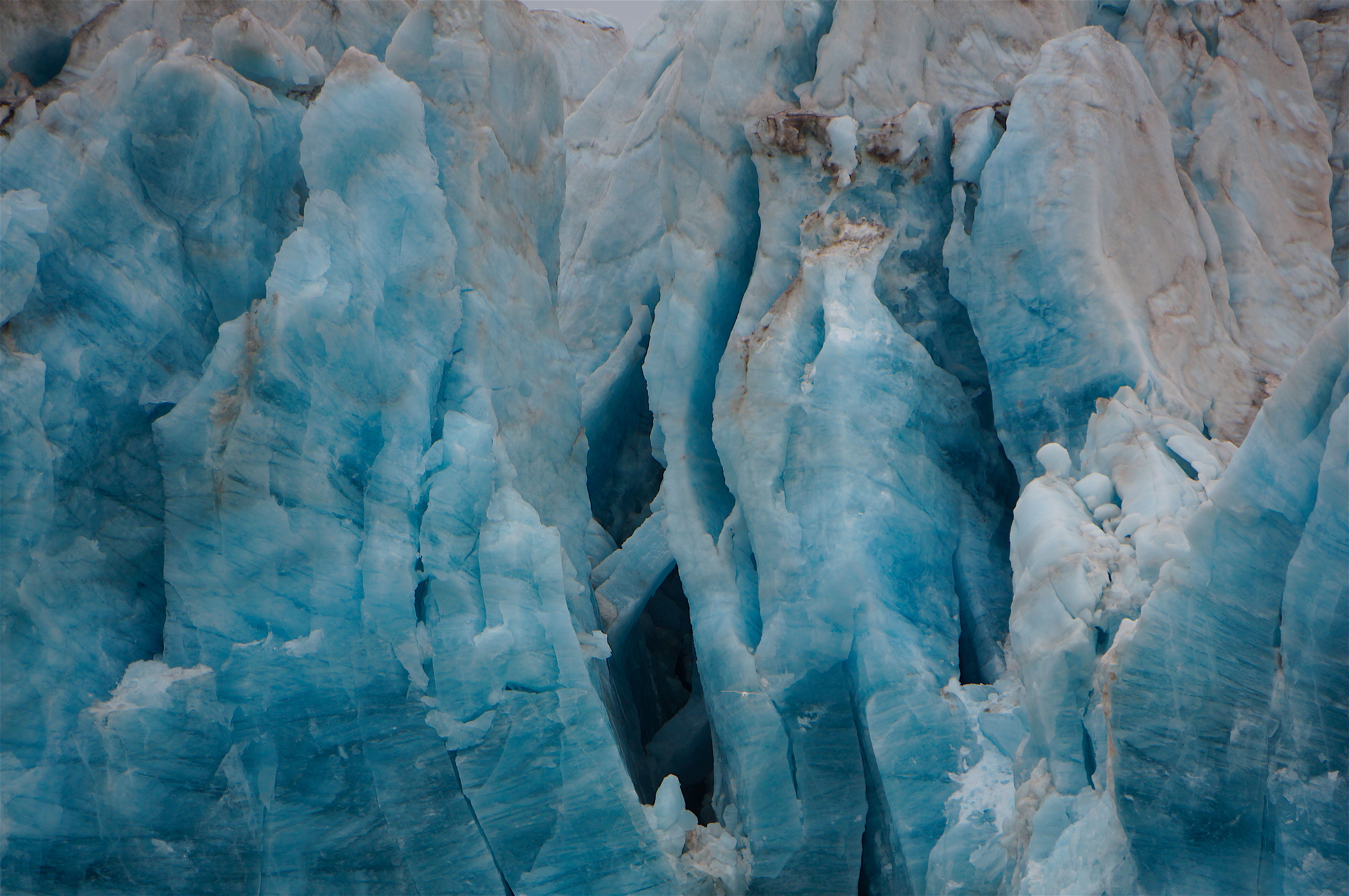
A close up in to the pinnacle section of the calving front. Internal collapses are common at Kronebreen, where ice behind the front collapses. This has been known to form columns of ice which appear isolated from the rest of the calving front, similar to geological sea stacks. Such ice columns are attached to the rest of the front beneath the waterline.

The pinnacle, viewed from the south side of Kronebreen. The front is approximately 50 metres high in this section. For some sense of scale, see the bird perched on the top of the ice column in the centre of the image. It is uncertain exactly why this preserved pinnacle exists at Kronebreen. It is likely that the section is pinned to a region of the sea bed, and its shape is exaggerated by two submarine plumes which are active either side of the pinnacle.
4. The 'traditional' tall ice cliff at the front of the fastest-flowing section of the glacier</strong>
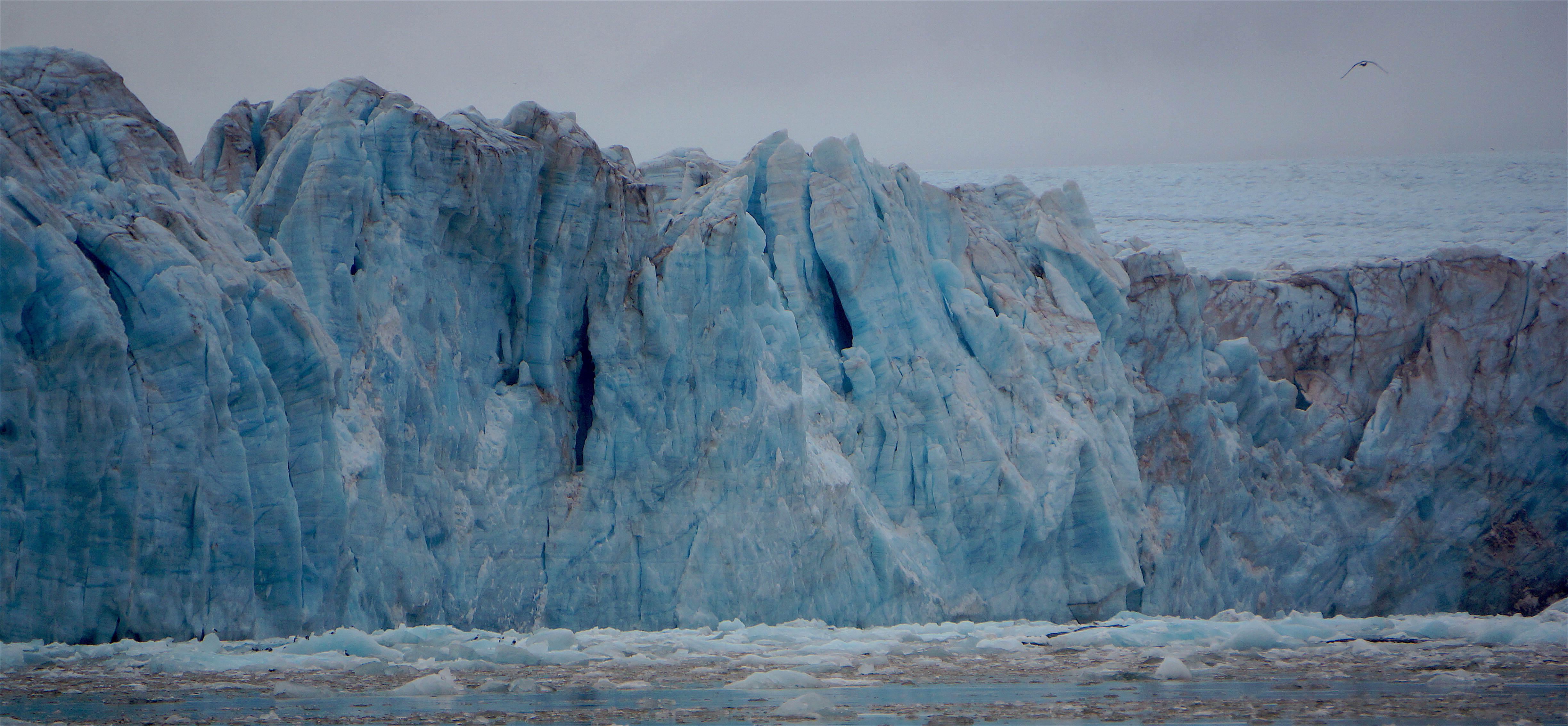
These tall ice cliffs are a common feature of marine-terminating glaciers. The steep profile of the face is maintained by the fast delivery of ice to the front. At Kronebreen, this part of the ice face is at the front of the fastest-flowing section, reaching velocities of 5 metres per day in the peak summer melt season. Calving activity is infrequent here, but events are often large with failures through the entire column of ice (at least above the waterline). Click here for an example of a calving event in this area captured in September 2015.
5. The shared margin with Kongsvegen
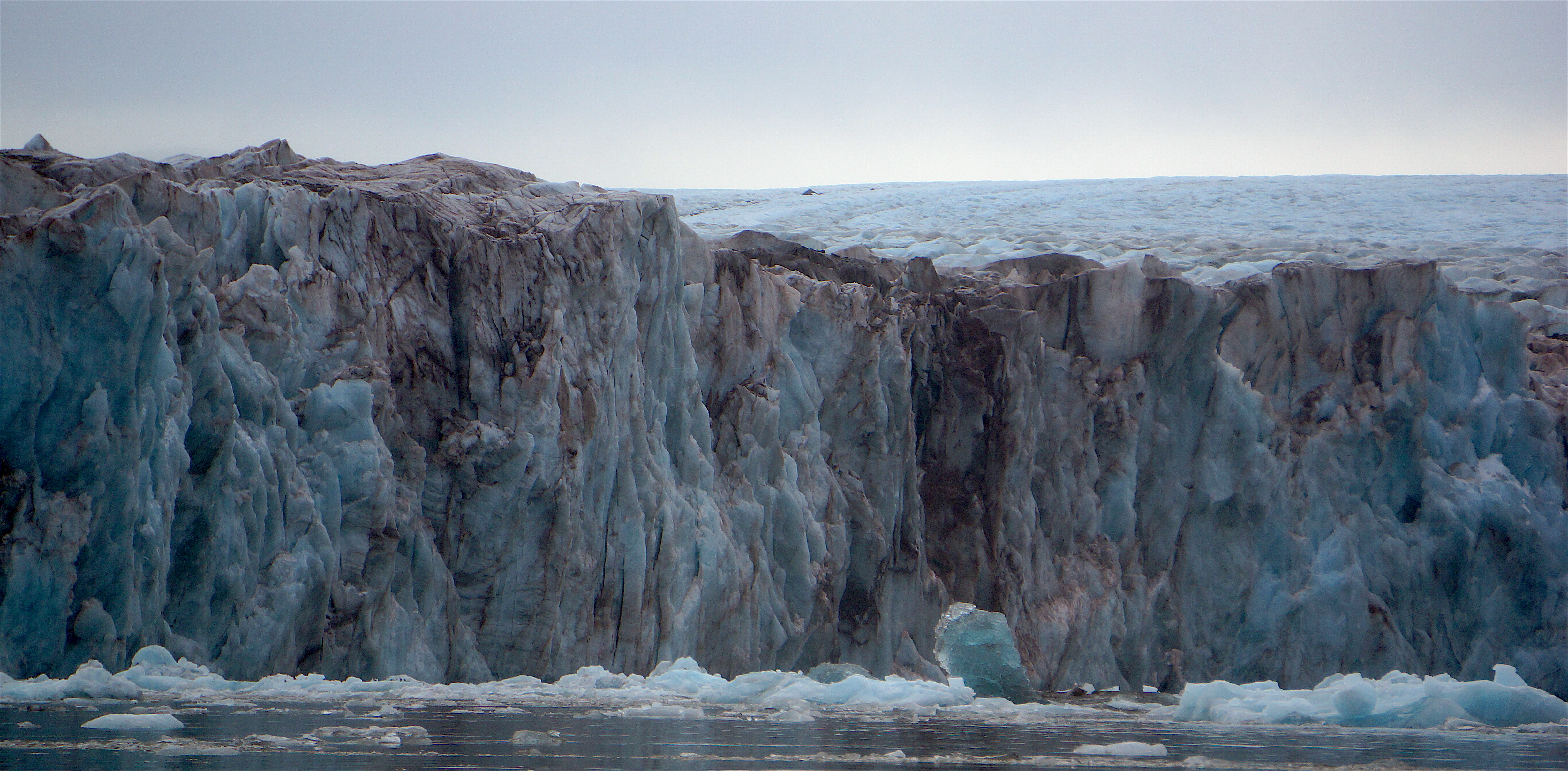
At the divide between Kronebreen and Kongsvegen is a section of dirty ice. This is a lateral moraine. As Kongsvegen has flowed into the side of Kronebreen, sediment has been squeezed and thrust to the surface between these two glaciers. The layers of sediment between the ice can easily be exploited and creates weaknesses at the ice front. There are often small ice falls and collapses in this area, with few large failures.
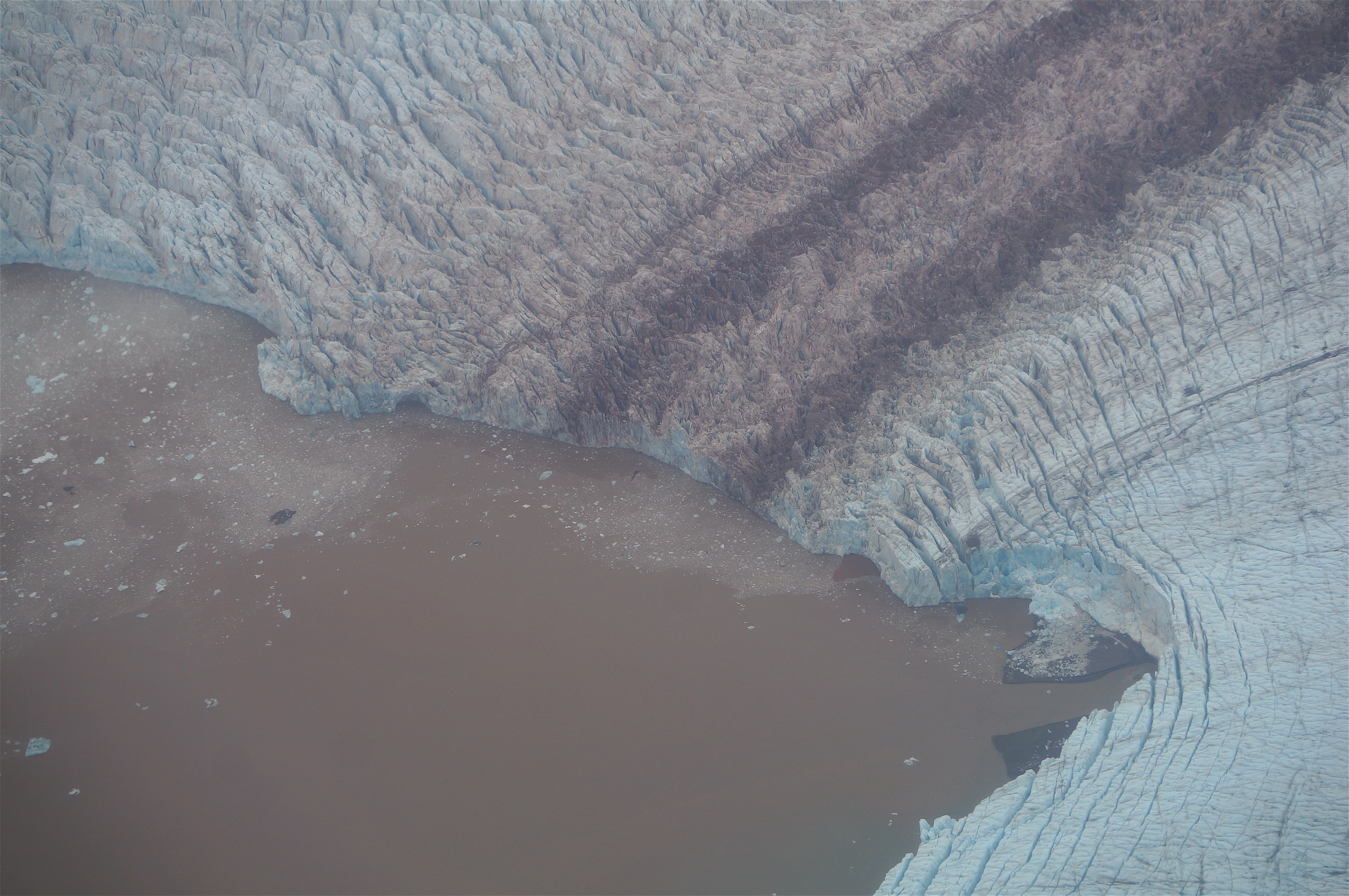
The shared margin from above. This large section of dirty ice is the lateral moraine where Kronebreen (left) meets Kongsvegen (right). A large inlet has formed (since approx. 2014) just to the south of the lateral moraine at the front of Kongsvegen. This inlet is roughly 200 metres deeper than the rest of the calving front, thought to be the result of weaknesses at the lateral moraine. This could be the beginning of Kongsvegen’s separation from Kronebreen. Another explanation is that a large meltwater channel exits the glacier here, exploiting weaknesses in the lateral moraine to create a large channel that has promoted calving activity in the immediate vicinity. From looking at this photograph, it is apparent that part of the inlet has now retreated to land (see the two small black sediment beaches that are in the inlet). The gap between these two beaches could be the location of this channel opening.
**All photos were taken from approx. 500m from the glacier front. It is generally advised to be AT LEAST 200 METRES from the front of any calving glacier in Svalbard. Being close to calving glaciers is dangerous and could result in serious injury or even death if a calving event were to occur. See here for more information issued by the Governor of Svalbard and Norsk Polarinstitutt, or google 'glacier calving accident' if you want to scare yourself silly.**
Further reading
AntarcticGlaciers.org article on stress and strain in glacial environments
Mauri Pelto's AGU blog on the mutual margin of Kronebreen and Kongsvegen
Calving activity at Kronebreen by Anne Chapuis et al. (2010)
Submarine plumes in Greenland by Kristin Schild et al. (2016)
